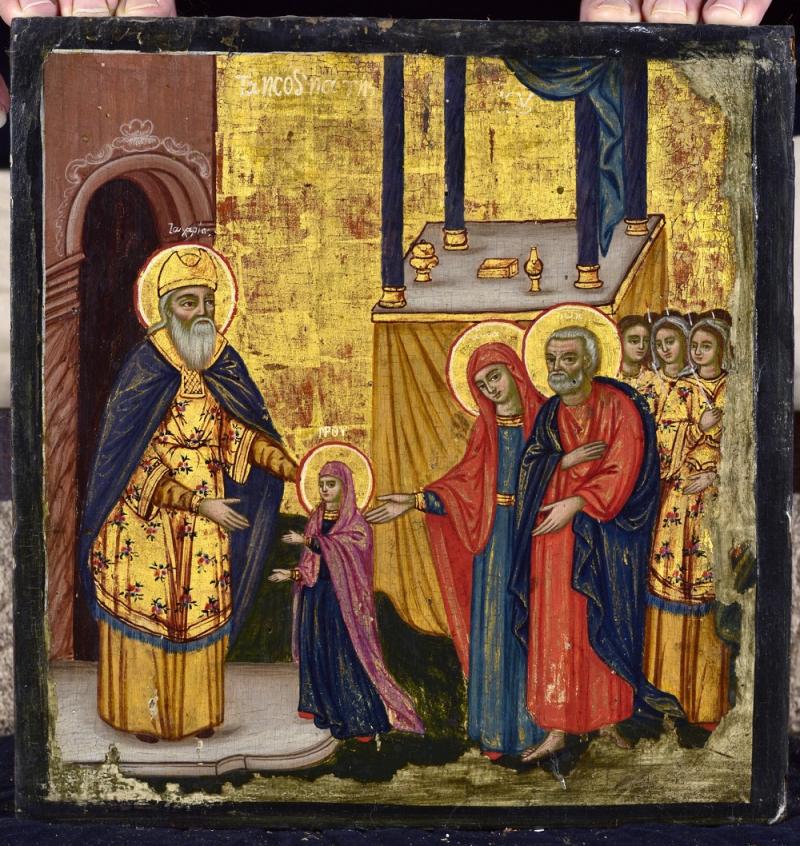On May 2, Holy Thursday, in the parish “St. Nectarius” in Zimbabwe, the first deaconess ordination of the local Christian Angelica was performed by Metropolitan Seraphim of Zimbabwe.
The event and the photos, in which the new deaconess gave communion to Christians in the parish, gave rise to lively comments that this was the first ordination of a woman in the Orthodox Church.
Metropolitan Seraphim said that the deaconesses in his diocese will help in the Liturgy and pastoral work: “She will do what the deacon does in the Liturgy and in all the sacraments in our Orthodox services. Her specific duties will be geared towards the specific needs of parishes in Zimbabwe.” And more: “One of the most important areas of the deaconess’s activity is the exercise in works of charity. The deaconesses were angels of mercy, sisters who visited the sick, the “mourning” and the poor women, teaching them the Holy Gifts of Christian love. The deaconesses visited the imprisoned Christians, bringing them Holy Gifts”. He noted that today the work of deaconesses would not be identical to that exercised in Byzantine times. However, “we must recognize that women can offer the Orthodox Church a great missionary work” and gives the example of their missionary, catechizing and teaching activities in Africa. The Metropolitan has chosen Maundy Thursday for this event because the Divine Liturgy celebrated on that day commemorates the establishment of the Eucharist. Thus, the ministry of the deaconess is connected with the Holy Eucharist, which is the center of the Christian life.
In fact, this is far from the first ordination of women as deaconesses in the Patriarchate of Alexandria. As is known, this tradition was revived by St. Nectarius of Aegis at the beginning of the 20th century and was sanctified by his authority as a saint and bishop. Periodically, ordinations for deaconesses take place under the jurisdiction of the Patriarchate of Alexandria, a practice imposed by missionary considerations and by conditions in the patriarchal and conservative societies of the African continent. For example, in 2017, on the day of St. Theodore Tiron, Patriarch Theodore celebrated the festive Holy Liturgy in Congo, during which he performed presbyterial ordination, and then he performed chirothesia (ordination) for the deaconess of the catechist of the Katanga metropolis – old woman Theona. She was one of the first members of the Orthodox Christian mission in Kol(o)wezi, Congo, and was given the title of “deaconess of the mission” of the Metropolitanate of Katanga. In addition to her, a prayer was read over three other nuns and two catechists “to enter the ministry of deacon” to serve the missionary activity of the metropolis, especially in the sacraments of Adult Baptism and Marriage, as well as in the catechism department of the local church.
The manner in which they were elevated to the deacon ministry shows that the Alexandrian bishops did not strictly follow the ancient order of ordination of women deaconesses preserved in Byzantine sources, which shows that women were ordained as deaconesses at the altar as well as male deacons. In Byzantium, women-deaconesses helped in the performance of the sacrament of Baptism of women, as well as they administered communion to women and children in homes. They were also involved in the charity work of the parishes. Being a deaconess was prestigious in society. Because of their social activity, wealthy women from the upper classes of society were ordained as deaconesses, for example, widowed wives of members of the synclit, daughters of high civil servants, members of bishops’ families. However, they donated all their property to the church community in which they served. Rule 15 of the Fourth Ecumenical Council sets the age of forty as the minimum age for their ordination. By imperial order, forty women deaconesses served in the “Saint Sophia” temple in Constantinople in the 6th century. This institution was established in church life from the 2nd to the 6th century, therefore naturally from the 6th to the 8th century the so-called “prayer for the ordination of deaconesses” developed in the Church, which is very reminiscent of the rank of deacon’s ordination. However, male deacons were immediately given ministry at the altar of the temple unlike female deaconesses. The most important functions of the deaconesses were in the baptism of women: they anointed the body of the baptized, while the bishops, respectively the priests, anointed only the forehead.
This did not give rise to controversies about “women’s priesthood” in the Church, because people had a different idea about the nature of the priestly ministry – its center and source was the bishop, who delegated by ordination these powers and duties of his to priests only. The deacon’s ministry was not seen as the “first degree of the priesthood”, but as another type of auxiliary ministry at the holy altar, which was not connected with the administration of sacraments. St. Epiphanius of Cyprus emphasizes that “deaconesses are a rank in the Church, but not in the priesthood.”
The reduction of the deacon ministry of men to the beginning of the career “priestly development” in the Church actually limits it and deprives it of its original meaning, which is connected (even from the first years of the Church of Christ in Jerusalem – see: Acts. ch. 6) before all with the charitable activity for the benefit of Christians.
It is no coincidence that the Holy Synod of the Ecumenical Patriarchate in its document adopted at the Pan-Orthodox Conference in 1988 on the island of Rhodes (this is the Inter-Orthodox Theological Conference “The Place of Women in the Orthodox Church and the Question of the Ordination of Women” recommends: “that the general order of deacons (men and women) be restored everywhere in its original and varied ministry, extending into the social sphere, in the spirit of the ancient tradition and in response to the growing specific needs of the modern world. It should not be limited to a purely liturgical role or seen as a degree for promotion to the higher ranks of the clergy.”
However, in the Orthodox Church, the ministry of women deaconesses was not revived, since the ministry of deacons was permanently perceived as the “first degree of the priesthood”, and deacons did not perform any other functions in the Church than liturgical ones during the Holy Liturgy.
It is no coincidence that the ministry of deaconesses is being revived, albeit very limited, in the Patriarchate of Alexandria, where there is an objective need for it. In local societies, women’s and men’s activities are strictly regulated and communication between the two sexes is subject to strict restrictions, which is an obstacle to the church life of women.
The Church has many women deaconesses in its festive calendar, especially in the 4th century – such was St. Teosevia, sister of St. Gregory of Nyssa, St. Susanna, the deaconess in Jerusalem, and many others. etc.
Illustration: Icon of the Feast of the Entrance into the Temple of Our Most Holy Lady the Theotokos and Ever-Virgin Mary.














 English
English French
French Spanish
Spanish German
German Dutch
Dutch Italian
Italian Danish
Danish Portuguese
Portuguese Greek
Greek Russian
Russian Swedish
Swedish Bulgarian
Bulgarian Hungarian
Hungarian Catalan
Catalan Ukrainian
Ukrainian Polish
Polish Basque
Basque Chinese (Simplified)
Chinese (Simplified) Japanese
Japanese Hebrew
Hebrew Arabic
Arabic Swahili
Swahili Amharic
Amharic Irish
Irish Afrikaans
Afrikaans Albanian
Albanian Armenian
Armenian Azerbaijani
Azerbaijani Belarusian
Belarusian Bengali
Bengali Bosnian
Bosnian Cebuano
Cebuano Chichewa
Chichewa Chinese (Traditional)
Chinese (Traditional) Corsican
Corsican Croatian
Croatian Czech
Czech Esperanto
Esperanto Estonian
Estonian Filipino
Filipino Finnish
Finnish Frisian
Frisian Galician
Galician Georgian
Georgian Gujarati
Gujarati Haitian Creole
Haitian Creole Hausa
Hausa Hawaiian
Hawaiian Hindi
Hindi Hmong
Hmong Icelandic
Icelandic Igbo
Igbo Indonesian
Indonesian Javanese
Javanese Kannada
Kannada Kazakh
Kazakh Khmer
Khmer Korean
Korean Kurdish (Kurmanji)
Kurdish (Kurmanji) Kyrgyz
Kyrgyz Lao
Lao Latin
Latin Latvian
Latvian Lithuanian
Lithuanian Luxembourgish
Luxembourgish Macedonian
Macedonian Malagasy
Malagasy Malay
Malay Malayalam
Malayalam Maltese
Maltese Maori
Maori Marathi
Marathi Mongolian
Mongolian Myanmar (Burmese)
Myanmar (Burmese) Nepali
Nepali Norwegian
Norwegian Pashto
Pashto Persian
Persian Punjabi
Punjabi Romanian
Romanian Samoan
Samoan Scottish Gaelic
Scottish Gaelic Serbian
Serbian Sesotho
Sesotho Shona
Shona Sindhi
Sindhi Sinhala
Sinhala Slovak
Slovak Slovenian
Slovenian Somali
Somali Sundanese
Sundanese Tajik
Tajik Tamil
Tamil Telugu
Telugu Thai
Thai Turkish
Turkish Urdu
Urdu Uzbek
Uzbek Vietnamese
Vietnamese Welsh
Welsh Xhosa
Xhosa Yiddish
Yiddish Yoruba
Yoruba Zulu
Zulu